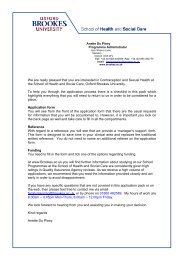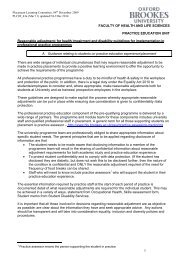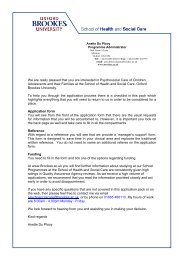Marion Hetherington - Faculty of Health and Life Sciences
Marion Hetherington - Faculty of Health and Life Sciences
Marion Hetherington - Faculty of Health and Life Sciences
You also want an ePaper? Increase the reach of your titles
YUMPU automatically turns print PDFs into web optimized ePapers that Google loves.
Institute <strong>of</strong> Psychological <strong>Sciences</strong>FACULTY OF MEDICINE AND HEALTHBenefits <strong>of</strong> satiety enhancement– do functional foods deliver?Pr<strong>of</strong>essor <strong>Marion</strong> <strong>Hetherington</strong>
Benefits <strong>of</strong> satiety to theconsumerAim:To consider <strong>and</strong> evaluate research on possible benefits <strong>of</strong>enhanced satiety <strong>and</strong> appetite control to the consumerMain questions:1. How is functionality defined?2. How do we describe <strong>and</strong> measure satiety?3. What foods or ingredients promote satiety?4. What do consumers underst<strong>and</strong> by “satiety” claims?5. What are the benefits?6. Do functional foods deliver ?
How is functionalitydefined?
Defining functionality
Defining functionalityAshwell (2001) PHN a food is functional ifa) provides a benefit beyond nutritional content by improving health <strong>and</strong> wellbeing or reducing risk <strong>of</strong> disease e.g. lowering cholesterolb) not pills nor capsules but part <strong>of</strong> a normal food pattern e.g. whole foods orenhanced foods
Food products with hungercontrol or satiety claims
Defining functionality: EUEC Concerted Action on Functional Food Science (FUFOSE) proposed aworking definitionhttp://www.ilsi.org/Europe/Pages/FUFOSE.aspxthose foods which are intended to be consumed as part <strong>of</strong>the normal diet <strong>and</strong> that contain biologically activecomponents which <strong>of</strong>fer the potential <strong>of</strong> enhanced healthor reduced risk <strong>of</strong> disease.e.g. foods that contain specific minerals, vitamins, fatty acids ordietary fibre, foods with added biologically active substances such asphytochemicals or other antioxidants <strong>and</strong> probiotics…..
EFSA consultation document(26 April 2011 to 31 August 2011)• changes in appetite ratings after consumption <strong>of</strong> a“test” food should also be observed after chronicconsumption <strong>of</strong> the food (e.g. after one month)• tests performed on a single occasion insufficient forsubstantiation• changes in energy intake must be shown over time;after chronic consumption <strong>of</strong> the food (e.g. after onemonth),•tests performed on a single occasion insufficient forsubstantiation.
www.hc-sc.gc.ca
“Satiety” claimsFood productNutrition shakeVanilla milkshakeOatmeal, cereal, milkshakesYoghurt, ready-to-eat mealsEgg proteinProtein shakeClaim“freedom from hunger”“re-programs appetite to reducehunger <strong>and</strong> cravings”“helps satisfy your hunger”“Fuller for longer”“helps you want to eat less”“keep me going to preventhunger”
How do we describe <strong>and</strong>measure satiety?
Satiety cascadeBlundell (1991)SensoryCognitivePost-ingestivePost-absorptiveFOODearlyLateSatiationSatiety
Defining satietySatiationthe process by which food intake is terminated; measuredby within meal ratings <strong>of</strong> appetite <strong>and</strong> ad libitum intake<strong>of</strong> single food or mealSatiety (post-pr<strong>and</strong>ial)inhibition <strong>of</strong> further eating, modulation <strong>of</strong> hunger in postingestiveperiodMeasured by magnitude or duration <strong>of</strong> changes insubjective ratings <strong>of</strong> appetite-related sensations usuallyby visual analogue scales (VAS)
Hunger precedes meal intake+HungerSatietySatietySatiety_Breakfast Lunch DinnerSatiation Satiation Satiation
What foods or ingredientspromote satiety?
Properties <strong>of</strong> foods which couldpromote satietyMacronutrient content (e.g. protein > fat)Fibre content (high fibre > low fibre)Glycaemic index (low GI > high GI)Energy density (low kcal/g > high kcal/g)Structure (solid food / viscous food > liquids)
Evidence from consumers<strong>Health</strong> benefits are important to consumerse.g. cholesterol lowering ingredientsPreventing disease <strong>and</strong> concerns about body weight arecommonly cited health considerationsManaging hunger is also mentioned in relation to weightcontrolHowever, satiety effects are experienced immediately <strong>and</strong>are easily discernible
What do consumersunderst<strong>and</strong> about satiety?Consumers describe fullness as• “a feeling <strong>of</strong> food in the stomach”• “stomach stretch”• “satisfaction• “lack <strong>of</strong> the desire to eat”• The term « satiety » is not typically usedMurray & Vickers Appetite (2009)
What do consumersunderst<strong>and</strong> about satiety?Bilman et al (2012) assessed underst<strong>and</strong>ing in 1504respondents in UK, Italy, France <strong>and</strong> GermanyMost correctly interpreted satiety claimsMajority did not extend satiety claim to include weightloss (no magic bullet) identifying personal efforts toachieve weight lossBut restrained eaters more likely to over-interpretsatiety claims for weight loss benefits
CaveatsWeight loss can only be achieved by sustained, goaldirectedchanges in lifestyle including diet <strong>and</strong>activity.Satiety enhancement per se cannot produce weight loss
What are the benefits?
Potential benefits <strong>of</strong> satietyReduced opportunistic eating (some consumers)Strengthen weak internal cues <strong>of</strong> satietyPleasure associated with lower energy food productswithout feeling “deprived”Reduced hunger dysphoriaImproved hunger managementImproved compliance with goal directed behavioursAdjunct to achieving weight loss <strong>and</strong> reducing the risk <strong>of</strong>weight gain
Goal directed behaviourSatiety enhancement may increase compliance with ahealthier dietLower ED foods/liquids may promote weaker satiety thanhigh ED foods/liquidsHunger management increases eating self-efficacy sohealthy eating goals may be more easily achievedSatiety enhancement may increase compliance with a weightloss diet (hunger <strong>and</strong> food cravings may impaircompliance)
Goal directed behaviourTargeting appetite using specific foods or meals can be ameans <strong>of</strong> managing hunger arising from periods <strong>of</strong>energy restrictionHunger management may help individuals resist the strongenvironmental <strong>and</strong> situational cues to overconsumeSuccess <strong>of</strong> pharmacological agents to manage hunger – canfoods provide a similar if more subtle effect on satiety(e.g. d-fenfluramine)
Benefits <strong>of</strong> hungermanagementPerceived hunger predicts failure to lose weight in clinicaltrials (Womble et al., 2001)Higher fasting state ratings <strong>of</strong> appetite associated withlower weight loss (Drapeau et al., 2007)Hunger is associated with weight regain (Pasman et al, 1999)Market research reasons for non-compliance to weight lossdiets:“Cravings for foods I love”“Always being hungry” (Unilever Strategic Segmentation Study, 2007, US)
Reduced hunger with highprotein low CHO dietsHPMCN = 17HPLCMean (SEM) daily hunger (mm), HPLC (ketogenic) diet <strong>and</strong> HPMC (nonketogenic) diet .Over the 4-wk period, hunger was significantly lower with the LC diet than with the MC diet .Johnstone et al (2008) AJCN
Weight loss maintenanceOverweight adults (n = 773) from 8 EUcountrieslost at least 8% <strong>of</strong> their body weight on an 800kcal low-calorie diet (LCD) then r<strong>and</strong>omised toone <strong>of</strong> 5 ad libitum diets to prevent weightregain over a 26-week period.Maintenance diets were either high or low inprotein <strong>and</strong> GI according to a two-by-tw<strong>of</strong>actorial design or a control dietCompletion rate <strong>and</strong> maintenance <strong>of</strong> weight losswere highest with the high-protein low GI diet;(Larsen et al., 2010).
High protein <strong>and</strong> low GI promoteweight loss maintenance
Model to underst<strong>and</strong>benefits<strong>Hetherington</strong> et al (2012) NRRsubmitted
SummarySatiety enhancement may be desirable to some consumersMay strengthen internal cues <strong>of</strong> satietyOffers pleasure without feeling deprivedPotential for improved dietary compliance (healthy diet orweight loss) since perceived hunger is a barrier todietary complianceFunctional foods for satiety may confer consumer benefitsincluding those related to weight managementDo functional foods deliver? Good short term evidencenbut long term studies as yet insufficient
AcknowledgementsILSI expert panelLouise Dye, University <strong>of</strong> LeedsLeigh Gibson, Roehampton UniversityNikolaj Gregersen, University <strong>of</strong>CopenhagenJason Halford, University <strong>of</strong> LiverpoolClare Lawton, University <strong>of</strong> LeedsHans van Trijp, Wageningen UniversityKaren Cunningham (Coca Cola)Anne Lluch (Danone)David Mela (Unilever)Athanasia BakaILSI staffFrederic Timmermans
















